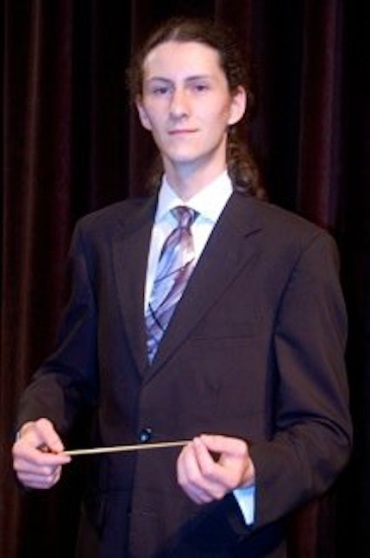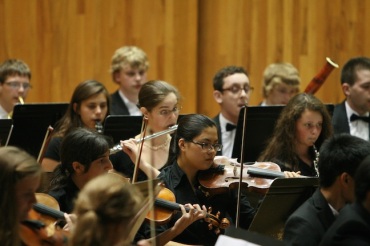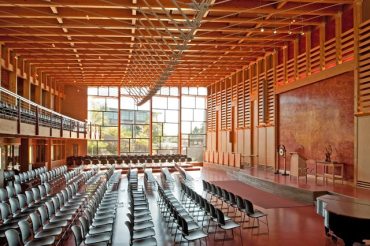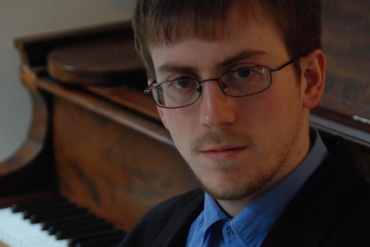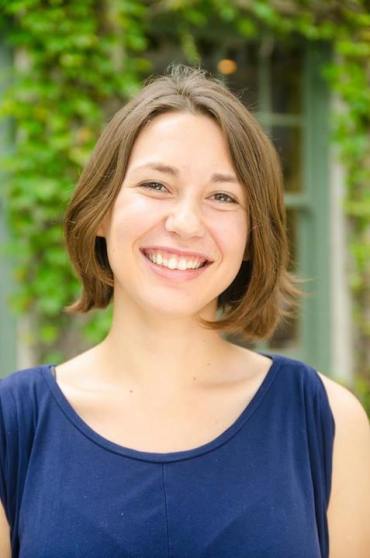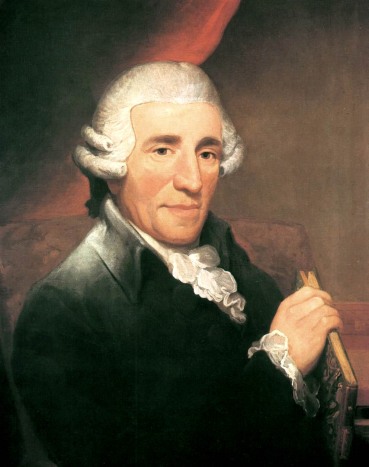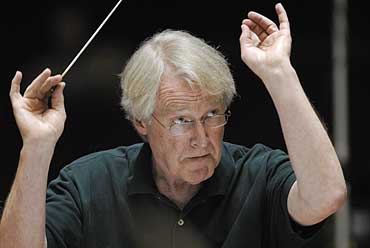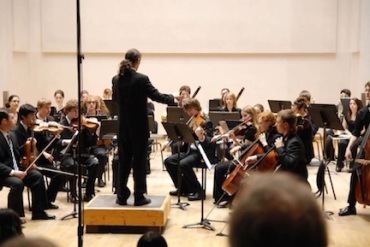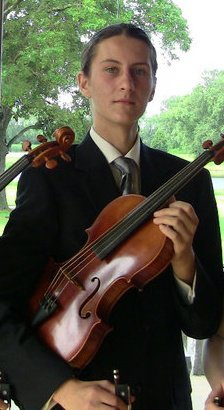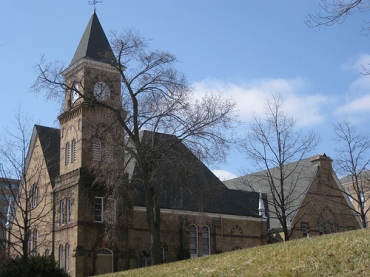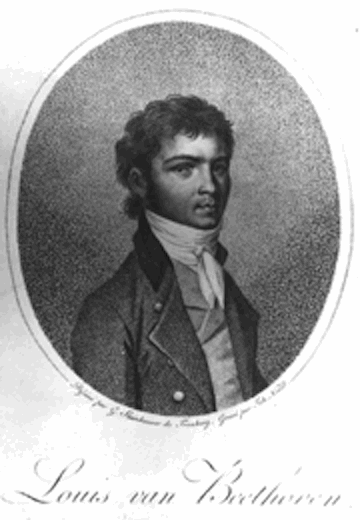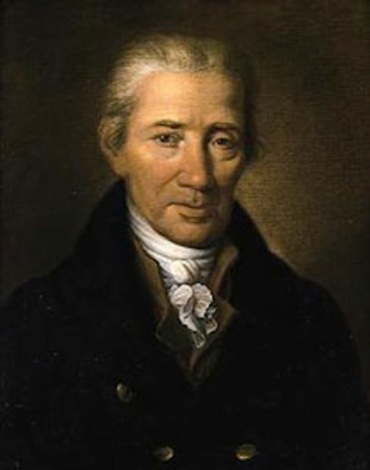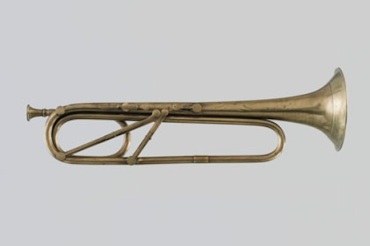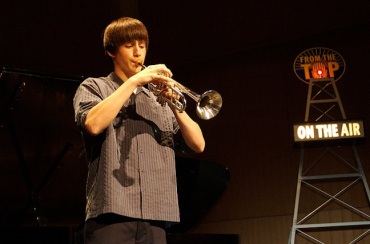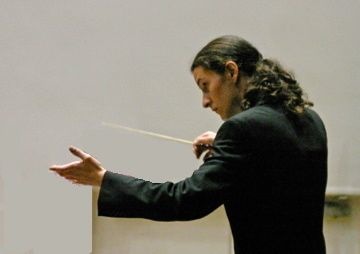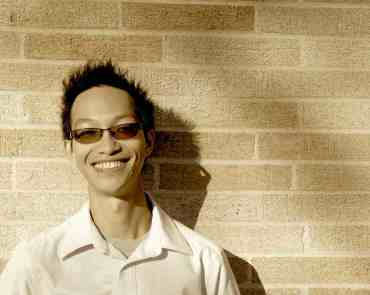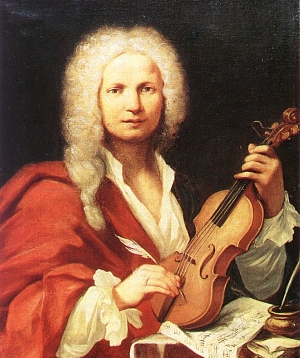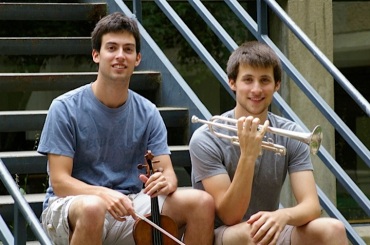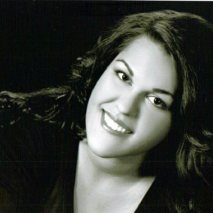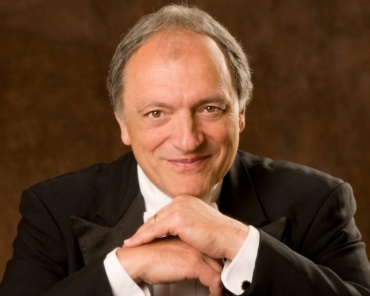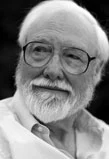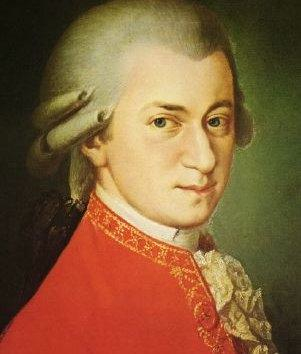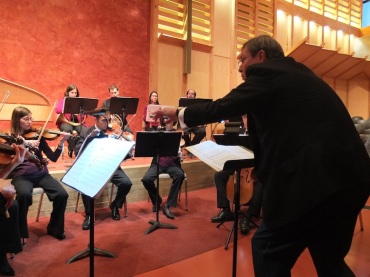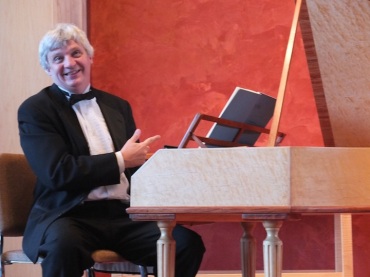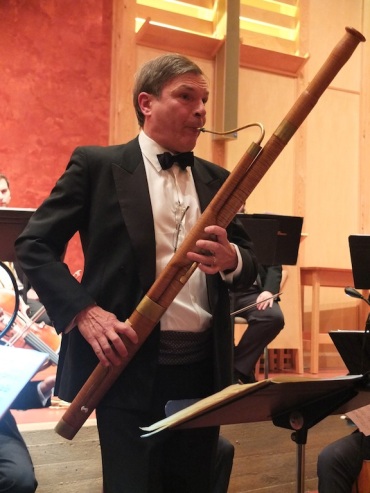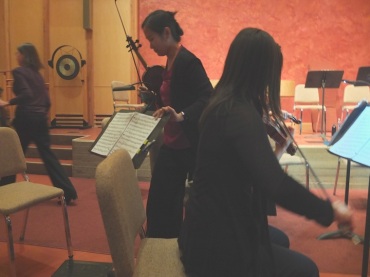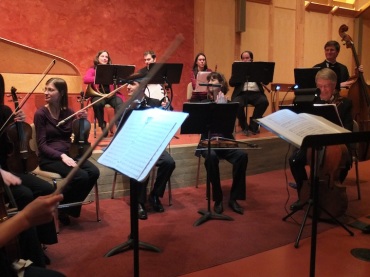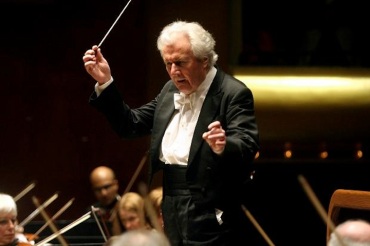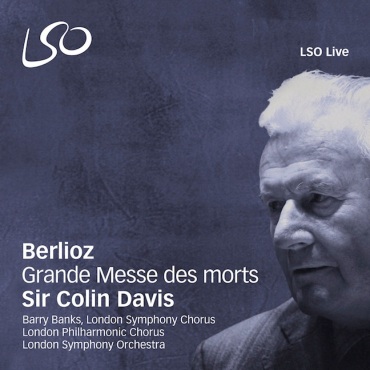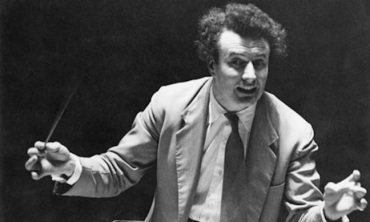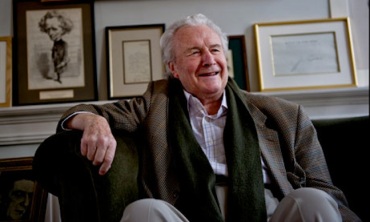The Well-Tempered Ear
Classical music Q&A: Norwegian trumpeter Tine Thing Helseth discusses being a female brass player and her program with the Madison Symphony Orchestra this weekend.
1 Comment
ALERT: Blog friend Rich Samuels writes: “At 7:22 a.m. on this Thursday morning, my classical music show “Anything Goes” that is broadcast weekly from 5 to 8 a.m. on WORT-FM 89.9 will be airing an interview with Norwegian trumpet soloist Tine Thing Helseth, who will be in Madison for concerts this weekend with the Madison Symphony Orchestra and a master class at the UW-Madison School of Music (see more below). Listeners can hear a sampling of her solo work as well as a performance by tenThing, her all-female Norwegian brass ensemble. Tune in to 89.9 FM.
By Jacob Stockinger
As he tells the story, Madison Symphony Orchestra’s longtime music director and conductor John DeMain was riding in his car and listening to Sirius XM radio. He heard a new recording by a terrific trumpet player and he was so impressed that he determined then and there that he would try to book her for a Madison concert — especially since most soloists he books are pianists, string players or singers.
Her name in Tine Thing Helseth (below), and DeMain succeeded. He booked her for a debut that will take place in Madison this weekend.
Helseth is young, energetic and articulate. She is also generous with her time and talent. In fact she will give master class for trumpet and brass players with the Wisconsin Youth Symphony Orchestras and a FREE public master class at the UW-Madison School of Music at 1:30 p.m. in Mills Hall on this Thursday, Feb. 13.
Then come her MSO concerts, which she will perform under the baton of DeMain in Overture Hall on Friday night at 7:30 pm.; Saturday night at 8 p.m.; and Sunday afternoon at 2:30 p.m.
Helseth will perform Franz Joseph Haydn’s well-known Trumpet Concerto in D Major and Alexander Arutiunian’s lesser known Trumpet Concerto in A-Flat Major (1920).
Rounding out the program is Jean Sibelius’ powerful and popular tone poem “Finlandia”; the symphonic suite from John Adams’ opera about physicist Edward Teller and the A-Bomb called “Dr. Atomic”; and the luscious late Romantic suite from Richard Strauss’ opera “Der Rosenkavalier,” a perfect offering for Valentine’s Day weekend.
A prelude discussion by musicologist Susan Cook, the new director of the University of Wisconsin School of Music, will take place in Overture Hall one hour before each curtain time.
Tickets are $8.25-$82.50 with rush tickets and discounts available. They can be purchased at the Overture Center box office, 211 State St., or by calling (608) 258-4141 or by visiting:
http://www.madisonsymphony.org/helseth
Here is a link to the MSO’s program notes, written superbly as always by trombonist J. Michael Allsen who also teaches at the University of Wisconsin-Whitewater:
http://facstaff.uww.edu/allsenj/MSO/NOTES/1314/5.Feb14.html
Helseth recently granted an email interview to The Ear:
Can you briefly introduce yourself, and tell us when and how you started studying music? How did you get into brass and what attracted you to brass and specifically the trumpet?
I started to play the trumpet when I was seven years old, basically because my mother plays the trumpet. I had played piano a couple of years already, but from the first moment the trumpet felt like my best friend — and we’ve stayed that way ever since! My mum had a good friend who played in the Norwegian Opera Orchestra, and she became my first teacher. I also played in my school band.
Do you find that being a woman plays any role, positive or negative, in your career or reception as a world-class trumpet player?
The most important thing as a performer will always be if you have something to say. Nothing else really matters.
But, that being said, I do feel comfortable with the fact that for some it might be a bit rare to see a woman having my profession. I feel a responsibility to show all the young kids out there that you can pick up whatever instrument you feel like, and make it your voice. Stereotypes can be boring. Just listen to your inner voice and follow your heart.
(Here is a link to a more extensive answer she gave about the issue of gender and sex roles in another interview:
What would you like to tell the audience about the Trumpet Concerto by Haydn (below)?
Franz Joseph Haydn’s trumpet concerto is basically the most famous concerto for my instrument. This year marks my very own 10-year anniversary for the first time I played it with a professional orchestra. I was 16 and it was with the Bergen Philharmonic in Norway.
This piece will forever have a truly special place in my heart. I play it several times a year, but I never get tired of it. There are always new things to discover, new colors and voices in the orchestra. It’s a true chamber music work, and I absolutely love performing it. (And she performs it very well. You can hear the final movement at the bottom in a YouTube video that has drawn more than 3.3 million hits.)
What would you like the audience to know about the Trumpet Concerto by Alexander Arutiunian (below)?
It’s very romantic in style, with clear folk music elements and the harmonics reveals that it’s written in the middle of the 20th century. It reminds me a bit of Khachaturian. It has beautifully melodic material and a really catchy fast theme.
These concerts mark your debut in Madison, perhaps even Wisconsin and the Midwest? Is there anything special you want to say about the city, the Madison Symphony Orchestra, conductor John DeMain or the rest of the program (Jean Sibelius, John Adams and Richard Strauss)?
I am just very much looking forward to coming to Madison and working with the orchestra and Maestro DeMain, and to meeting the audience. As a performer I live for the communication with the musicians I work with and with the audience. It’s always exciting to come to new places and communicate with music.
Tags: Alexander Arutiunian, Aram Khachaturian, Arts, brass, Classical music, concerto, Der Rosenkavalier, Doctor Atomic, Finlandia, Franz Josef Haydn, Haydn, Jacob Stockinger, Jean Sibelius, John Adams, John DeMain, Joseph Haydn, Madison, Madison Symphony Orchestra, master class, Norway, opera, Orchestra, Overture Center, Overture Hall, Piano, Rich Samuels, Richard Strauss, Sirius XM Radio, soloist, symphony, Tine Thing Helseth, tone poem, Trumpet, University of Wisconsin–Madison, WORT-FM 89.9, YouTube
Classical music: The Wisconsin Youth Symphony Orchestra’s Youth Orchestra will perform a FREE concert of classics this Wednesday night at 7 at the Gialamas Company’s 12th annual summer Concert in the Park at the Old Sauk Trails Business Park. Here are details and the background.
Leave a Comment
By Jacob Stockinger
Think of it as the Seventh Concert on the Square – except that the 12th annual Concert in the Park (below, in an aerial view) is from from downtown, located instead on Madison’s far west side in the Old Sauk Trails Business Park, 1200 John Q. Hammons Drive.
After all, it is OUTDOORS. And it is FREE. And it is on a Wednesday night – in fact this Wednesday night, Aug. 14, from 5-9 p.m., with the music starting at 7 p.m. sharp.
It is all very familiar friendly and features food and treats, including an ice cream social and a fireworks show.
But the annual Concert in the Park also has a few differences.
Here are some details about the event that is becoming increasingly popular as it becomes increasingly established as a showcase for young talent and a good time for the public.
For one, it is performed by the Youth Orchestra of the Wisconsin Youth Symphony Orchestras (WYSO) rather than the Wisconsin Chamber Orchestra. Any funds raised will benefit the Wisconsin Youth Symphony Orchestras (WYSO), which has taught more than 5,000 young musicians from over 100 communities in Southcentral Wisconsin since it was a founded in 1966.
For more information about WYSO, here is a link to WYSO: http://wyso.music.wisc.edu
Also, the guiding financial support comes from the Gialamas Company, a real estate development firm headed by husband George and wife Candy Gialamas (below) as well as from other sponsors.
For the fifth year in a row, the performers are extremely talented young students, WYSO’s premiere performing group (below) and who will perform under the baton of conductor James Smith, director of orchestras at the University of Wisconsin-Madison School of Music. And the repertoire is all classical music, drawn from the concert WYSO performances during its regular past season.
THE PROGRAM
Here is the generous, varied and very accessible program, with the timing in minutes included in parentheses:
Overture to “Die Fledermaus” by Johann Strauss Jr. (9); Suite from the opera “Carmen” by Georges Bizet featuring “Les Toréadors,” “Prelude et Aragonaise,” “Intermezzo,” “Les dragons d’Alcala,” the famous “Habanera” and the “Bohemian Dance” (15); First movement from the Concerto for Oboe and Orchestra by Franz Joseph Haydn with oboist Lauren McNeel (10); the Allegro resolute, alla Marcia from Symphony No. 2, “Antar” by Nikolai Rimsky-Korsakov (5); INTERMISSION The second movement from Symphony No. 2, “Romantic” by Howard Hanson (14); Allegro Appassionato from the Concerto No. 2 in D Minor for Piano by Felix Mendelssohn with pianist Vivian Wilhelms (10); Music for Symphony Orchestra by Yasushi Akutgawa (12).
By way of introduction, conductor James Smith (below) writes:
“The concert is a wonderful exposure for the WYSO program, and the concert is presented with the utmost professionalism because of the financial support from the Gialamas Company.
“We perform for an audience that finds the orchestra far exceeds their expectations, and it gives the members of the orchestra another chance to feel appreciated for their musical talent.
“Naturally, our traditional audience is primarily family and friends of the musicians. The Concert in the Park gives the orchestra a feeling of accomplishment and artistic validation.”
THE ACTIVITIES
You can arrive around 5 p.m. to enjoy pre-concert activities, to socialize and to picnic. You can set up lawn chairs and blankets at that time.
Schoep’s Ice Cream and The Gialamas Company, Inc. will once again be partnering with the Keep Wisconsin Warm/Cool Fund for the 5th Annual “Ultimate Ice Cream Social. All-you-can-eat ice cream is sold for $5 for adults, $3 for children, and $3 for a super scoop. Free face painting and coloring sheets are available for the kids. All the proceeds of this event go to keep the Heat and Power on for those most in need.
FOOD AND BEVERAGES
Appetizers, a picnic dinner and beverages are available from the concert caterers, Benvenuto’s Italian Grill or Sprecher’s Restaurant and Pub. Food and drinks must be pre-ordered and placed with the restaurant of your choice prior to tomorrow, TUESDAY, August 13. Food is delivered to sponsor tables between 5 p.m. and 6:30 p.m.
If you do not have a reserved sponsor table but still wish to order food, you may pick up your order at the event. Menus and ordering information can be found online at www.gialamas.com/events.
Sponsorships: Are still available. Contact Erica@gialamas.com for more information!
HOW IT GOT STARTED
Here is the history of the WYSO Concert in the Park as told by Candy Gialamas to Gialamas Company employee Erica Wiley:
How was the event started? Whose idea was it? How did the first year go?
It all began over 12 years ago. George and I went golfing with friends. The Clubhouse was closed by the time we were done, so one of our friends suggested a local restaurant that had an outdoor patio.
A group of musicians from the Wisconsin Chamber Orchestra was playing and after they were finished, Andrew Sewell, the conductor, came over and chatted with our table. After Mr. Sewell’s departure from the conversation, one of our friends suggested that we should put on a classical Concert in Old Sauk Trails Park.
Shortly thereafter, George asked me what I wanted to do for our anniversary … and I said an outdoor concert!
The first year, we only had one month to plan and orchestrate the entire event. Our Construction Manager, Andy and I took care of everything and the Wisconsin Chamber Orchestra performed. We invited friends, family and our tenant and the first year, 800 people showed up.
The last few years, we’ve had audiences of 5,000. The event continues to grow and flourish each year!
Do you or your children have a musical background or play an instrument?
Our entire family is very involved with numerous art and music organizations. George sang his way through college while attending Marquette University. Aris enjoys singing as well; Lana and Gina both took piano lessons as children. All of the Gialamas children have followed in our footsteps and are involved with various art and music boards and fundraising.
What about symphonic music inspires you? Why do you think everyone should experience a Symphony Concert?
The whole reason I wanted to start Concert in the Park was that music is a universal language and inspires feelings that everyone from any background and culture can relate to.
Symphony music can bring joy, sadness, excite or sooth and can inspire a range of emotions depending on the piece. Since the beginning of time people have used musical expression to tell stories, document events, etc. Music is an integral part of history.
What do you think of the Wisconsin Youth Symphony Orchestra performance as compared to a typical Symphony performance? (Editor’s note: You can hear WYSO perform the dramatic last movement of Dmitri Shostakovich’s famous Fifth Symphony in a YouTube video at the bottom.)
The last five years, we have asked the Wisconsin Youth Symphony Orchestra to perform at the event and could not be more pleased with their performance each and every year.
The talent that the youth musicians possess is absolutely amazing and inspiring. They give such an exceptional performance and you can feel their excitement at playing an outdoor venue in front of such a large crowd. The audience can truly see how much they enjoy performing. They are a wonderful group of musicians and we are proud to support them.
Tags: Felix Mendelssohn, Franz Josef Haydn, Georges Bizet, Gialamas Company, Johann Strauss Jr., John Q. Hammons, Madison, Nikolai Rimsky-Korsakov, Orchestra, Schoeps Ice Cream, University of Wisconsin-Madison School of Music, Wisconsin, Wisconsin Chamber Orchestra, Wisconsin Youth Symphony Orchestra, Wisconsin Youth Symphony Orchestras, WYSO, YouTube
Classical music: Founder and conductor Mikko Utevsky discusses the concert of music by Vivaldi, Haydn, Beethoven and Madison composer Jerry Hui this Friday evening by the Madison Area Youth Chamber Orchestra (MAYCO) that also features the two Norris brothers, also from Madison, as soloists.
Leave a Comment
By Jacob Stockinger
Loyal readers of this blog know well the name of Mikko Utevsky. The young violist this fall will be a sophomore at the University of Wisconsin School of Music, where he studies with Pro Area Quartet violist Sally Chisholm.
Utevsky, who has won awards and impressive reviews for his performances and his work in music education, is the founder and conductor of the Madison Area Youth Chamber Orchestra (below and at the bottom conducting MAYCO in the opening of Beethoven’s Fifth Symphony in a YouTube video), which will perform this Friday night at 7:30 p.m. in Music Hall on the UW-Madisob campus. (You can check out his many honors and projects by typing his name into the search engine on this blog site.)
Utevsky offered The Ear a short essay about the concert, and I immediately took him up on the offer. After all, he is a fine and perceptive writer who, you may recall, blogged for this post as he was on tour last summer with the Wisconsin Youth Symphony Orchestras‘ tour to Vienna, Prague and Budapest.
Here is the essay by Mikko Utevsky (below in a photo by Steve Rankin):
By Mikko Utevsky
This Friday evening, the Madison Area Youth Chamber Orchestra (MAYCO) will present an eclectic and, I hope, compelling program.
The concert will take place at 7:30 p.m. in Music Hall (below), on the campus of the University of Wisconsin-Madison at the foot of Bascom Hill. Tickets are $5 at the door; student admission is by donation.
The concert’s centerpieces are two masterworks of the Classical period, written only a few years apart: Beethoven‘s Symphony No. 1 in C major, Op. 21, and Haydn’s Trumpet Concerto in E flat. These two pieces, alongside a fantastic new work from Madison-based composer Jerry Hui that was commissioned for the orchestra, form the justification for the title “New Horizons.” Each work is a first in its own way.
The reasoning behind performing the work by the young Beethoven (below) is obvious: It is the composer’s first and strikingly mature essay into the symphonic form, which he would go on to revolutionize not once but three times in his career (his Third, Fifth and Ninth symphonies).
This relatively early work shows the depth of his debt to his teacher, Haydn, in its wit and formal clarity, though signs of the mature Beethoven are visible in the impetuous “sforzandi,” or sudden dynamic changes, and prominent wind writing.
The work by Haydn himself (below top) on the program is less obviously groundbreaking. It is one of his late works, composed when he was 64 for an old friend, trumpeter Anton Weidinger.
Its novelty lies in the instrument for which it was written: Weidinger (below middle) had developed a chromatically-capable trumpet (below bottom), intended to replace the natural trumpet that had been in common use up to this point. That instrument was incapable of chromatics, and even of stepwise melodies and scales in all but its highest register. Haydn exploits the new instrument to its fullest capacity in the most ingenious ways in this compact but brilliant concerto.
I am delighted to welcome as our soloist Madison native, former “Final Forte” performer, “From The Top” guest, and two-time National Trumpet Competition winner Ansel Norris (below).
Finally, Madison composer Jerry Hui’s tone-poem “Glacies” will receive its world premiere on Friday.
The performance of new works is an important part of MAYCO’s educational mission, and whenever possible we seek out music from local composers for the ensemble. New music challenges us as performers in many ways, introducing us to new styles and daring us to find joy and excitement in the unfamiliar. Working with Jerry is always a pleasure, and I sincerely hope the orchestra and audience enjoy his music as much as I do.
“Glacies’” is a wonderfully colorful work that should be both exciting and accessible to all audiences.
I’ll let him introduce it. Here are comments by composer Jerry Hui (below):
Mikko, founder of MAYCO, was a former composition student of mine, studying counterpoint and harmony with the support of the Wisconsin Center for Academically Talented Youth (WCATY), and I’m glad to compose a piece for his wonderful ensemble.
“Glacies is a orchestral tone-poem commissioned by Mikko Utevsky for the Madison Area Youth Chamber Orchestra (MAYCO). Mikko, the founder of MAYCO, was a former composition student of mine, studying counterpoint and harmony with the support of the Wisconsin Center for Academically Talented Youth (WCATY), and I’m glad to compose a piece for his wonderful ensemble. Glacies is the Latin word for ice, signifying my original inspiration for the work.
“As a Madisonian living near the lake for the past five years, I have become fascinated by the serene mystery of morning mist rising from the large frozen body of water, as well as the first spring day when the ice breaks–which sometimes can become an exciting and violent event known as an icequake.
“Glacies” does not attempt to tell a narrative; rather, I try to convey an impression of it through various sound and color of the orchestra.”
–Jerry Hui
Rounding out the program is a short double concerto in B-flat major by Antonio Vivaldi (below), originally for oboe, violin and string orchestra with basso continuo. The oboe part will be played on the trumpet, as recorded by the inimitable Maurice Andre, as an encore for our soloist from the Haydn concerto.
Ansel Norris will be joined by his brother, violnist and MAYCO’s concertmaster Alex Norris, himself a graduate of the UW-Madison School of Music. (Both brothers are pictured below, Alex on the left and Ansel on the right, in a photo by their mother Kathy Esposito.)
As for MAYCO’s future plans: While a lack of foreknowledge about instrumentation and the dates of competing summer offerings prevents me from providing concert dates or program details for next summer, I can give a few general hints about what is to come in the orchestra’s fourth season:
– Two varied concert programs featuring Classical masterworks and lesser-known gems.
– The world premiere performance of a work written for the orchestra by a local composer.
– The showcasing of local artists as soloists, including both younger performers and established older musicians.
More specifically, I hope to program the orchestra’s first piano concerto, and have been eyeing the prospect of working with vocalists again since I heard UW-Madison graduate student Shannon Prickett’s marvelous singing of Verdi and Puccini last summer, perhaps in the context of a concert performance of some opera scenes. But neither of those are promises. Stay tuned! (Shannon Prickett is shown below.)
Finally, I am planning to extend some of MAYCO’s offerings into the school year. We will be holding at least one outreach and reading session on a Saturday afternoon, at which current WYSO members will be invited to read some of the Classical repertoire that the orchestra specializes in and learn about the program we offer.
(Editors note: For more background information, read the entry of the UW School of Music’s outstanding blog “Fanfare”:
http://uwmadisonschoolofmusic.wordpress.com/2013/08/06/mayco-four-seasons/
Tags: Anton Weidinger, Antonio Vivaldi, Bascom Hill, Beethoven's Fifth, chamber orchestra, Classical, Classical period (music), concertmaster, Franz Josef Haydn, Giacomo Puccini, Giuseppe Verdi, Jerry Hui, Ludwig van Beethoven, Madison, Madison Area Youth Chamber Orchestra, MAYCO, Mikko Utevsky, National Trumpet Competition, Oboe, Orchestra, Trumpet, University of Wisconsin–Madison, Violin, Wisconsin, WYSO, YouTube
Classical music: A special Madison Symphony Orchestra season subscription offer expires today. And MSO guest trumpet soloist Tine Thing Helseth heads up a new summer music festival.
2 Comments
By Jacob Stockinger
In case you don’t already know, today is the expiration date of a special offer for subscribers to the Madison Symphony Orchestra (below).
Not only can you save up to 50 percent but you could also see the handling fee waived and also receive a free copy of a CD by John DeMain and the MSO that was done in Overture Hall of the Overture Center.
Here is a link for more information about the subscription and about the concerts in the 2013-14 season, including the special one-time only “Behind the Notes” performance of Dvorak’s “New World” Symphony:
http://madisonsymphony.org/13-14
As you may recall, this coming season is the celebration the 20th year that John DeMain (below) has been music director of the symphony. He has selected a lot of special programs – though some of us are disappointed that there is no Mahler symphony or song cycle and no Bruckner symphony on the list.
The programs include an all-Beethoven program with acclaimed pianist Yefim Bronfman (below) perform two piano concertos (Nos. 2 and 5); the fabulous violinist Augustin Hadelich in Lalo; the Mozart Requiem and an all-American concert with Gershwin and Leonard Bernstein among other composers.
But one big surprise was DeMain’s choice of a Norwegian trumpeter player – and a female trumpet player, which is rarer still – to appear as a new guest soloist in two trumpet concertos, including the famous one in E-flat Major by Franz Josef Haydn.
Her name in Tine Thing Helseth (below).
At the publicity launch of the new season last spring, DeMain explained to The Ear that he heard playing on Sirius Radio while he was driving in his car, and he was quite impressed.
He also said that he thought it would be interesting for MSO audiences to hear a different soloist, someone besides the usual pianist, violin, cellist or singer.
Time and the box office will tell how big the appeal of a brass player as soloist is.
But it turns out that DeMain isn’t the only one impressed with her talent.
In fact, Helseth has been put in charge of a new summer music festival.
Here is a link to the story:
http://www.gramophone.co.uk/classical-music-news/tine-thing-helseth-launches-new-festival
Here is a link to Helseth’s own website:
http://www.tinethinghelseth.com
And here is a sample of Helseth’s playing — in the last movement of the Haydn Trumpet Concerto that she will perform here in Madison — in a YouTube video:
Tags: American music, Anton Bruckner, Augustin Hadelich, Franz Josef Haydn, George Gershwin, Gustav Mahler, Jacob Stockinger, John DeMain, Leonard Bernstein, Madison Symphony Orchestra, Overture Center, Requiem, Tine Thing Helseth, Trumpet, United States, Wolfgang Amadeus Mozart, Yefim Bronfman, YouTube
Classical music: The Madison-based Ancora String Quartet ends its 12th season with a recital this Saturday night of chamber music by Dvorak, Haydn and Shostakovich.
1 Comment
By Jacob Stockinger
The critically acclaimed Ancora String Quartet will close its 12th season this coming Saturday night at 7:30 p.m. at the First Unitarian Society, 900 University Bay Drive, where the group performs as artists-in-residence.
Members (below, in a photo by Barry Lewis) of the Ancora Quartet are: violinists Leanne Kelso League and Robin Ryan, violist Marika Fischer Hoyt and cellist Benjamin Whitcomb, who teaches at the University of Wisconsin-Whitewater.
The Ear has heard and seen the quartet and knows that it performs with conviction and vivacity, often in unusual and intriguing programs.
This time the quartet will perform a program of 18th, 19th and 20th century music in the handsomely woody, crisp and sonically bright Atrium Hall (below in a photo by Zane Williams) rather than the old Landmark Auditorium of the Frank Lloyd Wright-designed church.
Tickets are sold at the door: $15 for general admission; $12 seniors and students; and $6 for children under 12
Here are some remarks by the quartet’s violist spokesperson Marika Fischer Hoyt, who is also a weekend radio host for Wisconsin Public Radio: “We are closing our 12th season. We’re pretty serious fans of the Bard in this quartet, and we decided to go with a Shakespearean theme: “Twelfth Season: “If music be the food of love, play on!” For the sports fans out there, we’re simply calling this season the Big 12.
“Dodecahedral elements (permutations of 12) permeate our May recital program, which features selections (Nos. 1, 3, 8, 9, 11, 12) from the 12 “Cypresses” by Antonin Dvorak (below, and at the bottom in a YouTube video, where the Emerson Quartet plays No 3).
Plus, she notes, “Like our Fall 2012 program, this May 2013 program includes exactly 12 movements of music.”
Adds Fischer Hoyt: About the Dvorak, she adds: “We’re very pleased with this program, and feel that it offers variety and balance. The six Dvorák “Cypresses” are intimate expressions of a young man’s unrequited love, and cover the gamut from tender, wistful longing, to jaunty descriptions of nature, to jealous frustration. Dvorak played the viola himself, and wrote so well for that instrument. The viola gets the opening melodies in the first two Cypresses that we’re playing, so don’t be late or you’ll miss them!”
“The Quartet in C Major, OP. 20, N. 2, by Franz Josef Haydn (below) will also be performed.
Adds Fischer Hoyt: The Haydn quartet Op. 20 No. 2 is one of the celebrated ‘Sun’ quartets, with a glorious cello melody in the first movement. The last movement is a quadruple fugue, but it’s not at all daunting; in fact, quite the reverse. It twinkles along merrily, and Haydn provides it with a whimsical inscription in Latin: “Laus. Omnip. Deo. Sic fugit amicus amicum,” or “Praise the Lord. Thus one friend flees another friend.” Haydn had such a great sense of humor!
“And the Quartet No. 12 (which also uses 12-tone techniques) by Dmitri Shostakovich (below) will round out the program.
Adds Fischer Hoyt: “In the last piece on our program, Shostakovich nods to serialism by featuring a 12-tone row (an intentionally atonal collection of 12 pitches), but then thumbs his nose at serialism by setting the row in the tonal key of D-flat major. This is not conventionally pretty music, but it has a nuanced complexity, an inner integrity, and a through-line of development that rivets the attention from the beginning to the end. I think when you play or listen to Shostakovich, you need to allow yourself to be transformed, or at least to go on a journey with him, and with us.”
A champagne reception will conclude the evening.
For more information visit: http://ancoraquartet.com
Tags: 12-tone, Ancora String Quartet, Antonín Dvořák, Dmitri Shostakovich, Emerson String Quartet, First Unitarian Society of Madison, Frank Lloyd Wright, Franz Josef Haydn, Jacob Stockinger, Shostakovich, University of Wisconsin, University of Wisconsin-Whitewater, Wisconsin, wisconsin public radio, YouTube, Zane Williams
Classical music: The Madison Bach Musicians venture beyond the Baroque into the Classicism of Haydn and Mozart with impressive results.
2 Comments
By Jacob Stockinger
Here is a special posting, a review written by frequent guest critic and writer for this blog, John W. Barker. Barker (below) is an emeritus professor of Medieval history at the University of Wisconsin-Madison. He also is a well-known classical music critic who writes for Isthmus and the American Record Guide, and who hosts an early music show every other Sunday morning on WORT 88.9 FM. He serves on the Board of Advisors for the Madison Early Music Festival and frequently gives pre-concert lectures in Madison
By John W. Barker
In its program on Saturday night (repeated Sunday afternoon), Trevor Stephenson’s Madison Bach Musicians took a bold step forward. Certainly so in chronology, going beyond their usual halting point at Bach’s demise (1750) to sample music of the later 18th century.
The composers represented were the two giants, Haydn and Mozart (below top and bottom respective): a concerto and a symphony for each.
This move is partly an expansion of Stephenson’s growing new collaboration with Marc Vallon, the world-class bassoon virtuoso on the UW Music School’s faculty, who has plunged into earlier literature for his instrument, but who has also ventured into conducting. (Below is Marc Vallon conducting Haydn.).
Examining the program by genres rather than composers, we find one concerto featuring each of the two leaders.
Stephenson opened the program with Haydn’s familiar Keyboard Concerto in D, notable for its Hungarian Rondo finale.
The work was probably written for harpsichord, but is today misrepresented on the modern piano. Stephenson took a middle road, using a fortepiano, a predecessor of the modern piano, and one with tone coloring and character of its own.
Further, Stephenson played discreet keyboard continuo in the Haydn Symphony and the Mozart Concerto that followed–certainly correct for Haydn, who would have led his ensemble from the keyboard to keep everybody together.
Vallon (below) gave a fruity and colorful rendition of the solo part in Mozart’s Bassoon Concerto in B-flat, leading the orchestra along the way. In the two Symphonies, he took over full conducting functions, using enthusiastic body language, but contributing phrasing and agogics that revealed fine musical insight.
The Haydn Symphony was No. 45 in F-sharp minor, known as the “Farewell.” Written in a willfully weird key, it is full of wild, even angry music, until its epilogue, in which the composer makes a plea to his employer, on behalf of his overworked musicians, for a long-deferred vacation.
This is done by the clever touch of having members of the orchestra drop out and leave one by one until only two violins remain. This game was played out with relish by our performers. (At bottom is a YouTube video of the finale of Haydn’s “Farewell” Symphony played by another group.)
The Mozart Symphony, his No. 29 in A major, is a work of youthful brio and charm, one of his earliest masterpieces in the form.
All these works are marked by elements of humor. The two concertos, especially that for bassoon, pokes gentle fun at the solo instrument in musical gamesmanship. Aside from the “departure” joke in Haydn’s Symphony, both of them featured the same use of surprise, in the Menuet movements for each, with comically abrupt endings.
Above all, however, this concert was an important landmark of sorts: the first time (if I am right) that anybody has assembled in Madison a working recreation of a late-18th century orchestra. One feature of this fact is numbers: 12 string players plus pairs of players on oboes and horns. Moreover, these were period-style instruments, the strings made of gut and played without vibrato.
The total result was a lean sound drastically different in tone, texture and balances from that we are accustomed to in the “modern symphony orchestra.” The players were all quite expert in their skills, many coming from widely scattered points around the country–such is Trevor Stephenson’s far-reaching network by now.
I could have wished for just a little tighter ensemble from the violins (as might come with more regular and consistent working together), but the playing was committed and artistic.
The texture allowed the sometimes ferocious discords in Haydn’s Symphony to sound with powerful effect, while the overall balances allowed the horns to ring out, even dominating at times, instead of being buried under lush string sound. In the Mozart Symphony, one could hear the clever harmonic and rhythmic material the composer gave to the violas (an instrument he himself loved to play).
This was, as I say, a landmark event in Madison’s musical history, and more. The program, played at the new Atrium Auditorium (below, in a photo by Zane Williams) of the First Unitarian Society, was preceded, as always, by a witty and informative talk by Stephenson. The quite large audience (I would guess at least 250 attendees on Saturday) was enthusiastic, and justly so at a concert both significant and wondrously enjoyable.
Classical music: The great British conductor Sir Colin Davis is dead at 85. Here is a round-up of stories and remembrances, appreciations and obituaries.
1 Comment
By Jacob Stockinger
In case you haven’t already heard, the great British conductor and longtime music director of the London Symphony Orchestra Sir Colin Davis (below) died last Sunday at 85 after a brief illness.
The news came unexpected to The Ear as Davis seemed actively involved in conducting almost up to the end. He seemed to have the stamina that would take him well into his 90s – especially since the aerobic act of conducting seems conducive to conductors have long careers and lives.
But then again, the obituaries make it clear that he suffered deeply from the death of his wife.
I never heard him live. But I loved his recorded performances –- and he recorded prolifically with some 250 albums to his credit. In the works of Sibelius and Berlioz he was a stalwart champion and acclaimed master. He also championed British composers such as Edward Elgar, William Walton and Benjamin Britten.
But I also liked his complete command of the Classical era-style in Mozart, Haydn and Beethoven – symphonies, concertos, operas, oratories and other choral works. (Below is the cover of his recording on the London Symphony Orchestra‘s own in-house label LSO Live of the Berlioz Requiem.)
Sir Colin earned fame and a fine living early on (below) in the 1950s and 1960s. But I especially liked that his career seemed to peak late in his life –- a good riposte to the cultural tendency today to worship prodigies and young achievers. He was never better than when his hair turned white.
There is also something endearing and Britty eccentric about Davis who liked to sit in a chair and think about musical interpretations while he was puffing on his pipe and knitting.
Yes, knitting.
And in his stage performances and touring, and it sounds to The Ear as if Sir Colin led a very good and very full life. Which may help explain why Sir Colin’s music-making sounded so healthy and robust and natural rather than neurotic or forced. (Below is a photo of Sir Colin at his home.)
Anyway, here are links to some of the best stories, remembrances and obituaries I found along with a fitting YouTube video of Sir Colin conducting Mozart’s Requiem at the bottom):
Here is a comprehensive and compassionate overview of Sir Colin’s life and career from NPR’s always outstanding blog “Delayed Cadence”:
And here is a story from Sir Colin’s native UK:
Here is a column, with some details of Sir Colin’s personal life and turmoil, by Anne Midgette of The Washington Post:
Here is a link to BBC report:
http://www.bbc.co.uk/news/uk-22148334
Here is a link to report from The New York Times:
http://artsbeat.blogs.nytimes.com/2013/04/14/sir-colin-davis-british-conductor-dies-at-85/
And here is a story from another UK source, The Guardian:
http://www.guardian.co.uk/music/2013/apr/14/sir-colin-davis-obituary
Here is a report from the UK wire service Reuters:
http://uk.reuters.com/article/2013/04/15/uk-davis-idUKBRE93E0BJ20130415
And here are two more from the Los Angeles Times and The Huffington Post:
Did you hear Sir Colin live? What did you think?
Do you have a favorite recording?
A word of tribute about Sir Colin to leave in the COMMENTS section?
The Ear wants to hear.
Tags: Anne Midgette, Beethoven, Benjamin Britten, Berlioz, Classical, Colin, Colin Davis, Davis, Edward Elgar, Franz Josef Haydn, Jacob Stockinger, Jean Sibelius, London, London Symphony Orchestra, Los Angeles Times, Mozart, New York Times, NPR, Requiem, Royal Opera House, Sibelius, Washington Post, William Walton, YouTube





